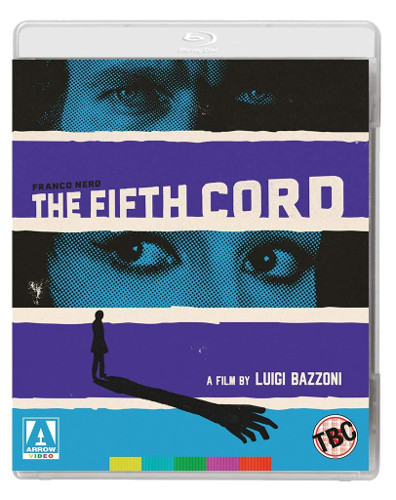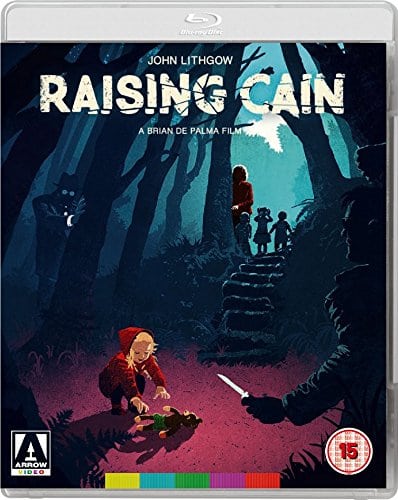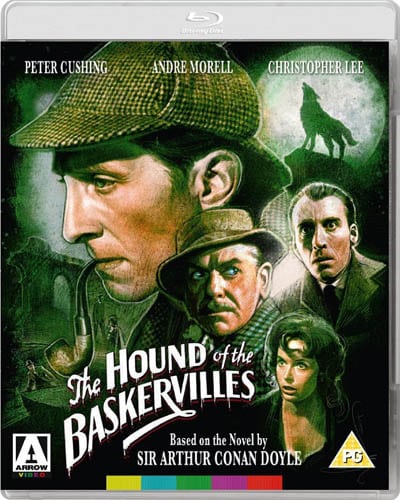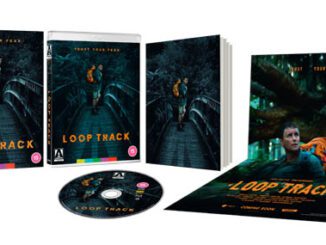The Fifth Cord (1971)
Directed by: Luigi Bazzoni
Written by: David McDonald Devine, Luigi Bazzoni, Mario di Nardo, Mario Fanelli
Starring: Franco Nero, Ira von Fürstenberg, Silvia Monti, Wolfgang Preiss
AKA GIORNATA NERA PER L’ARIETE, BAD DAY FOR ARES
Italy
AVAILABLE ON BLU-RAY: 4th February, from ARROW VIDEO
RUNNING TIME: 91 mins
 Andre Bild is a reporter with a serious drink problem. He has an on-off girlfriend named Lu Auer, but still holds a torch for his ex Helene, who’s been married for the last few years but is currently going through a divorce. When school teacher John Lubbock is nearly beaten to death while walking home from a New Year party Andre was at, Andre, who can’t remember what he did due to being drunk, is the prime suspect, though he thinks it could be someone else who was at the party. Then the wheelchair-bound Sophia Bini, another guest, is strangled in her house with one finger severed and a black glove left as a calling card….
Andre Bild is a reporter with a serious drink problem. He has an on-off girlfriend named Lu Auer, but still holds a torch for his ex Helene, who’s been married for the last few years but is currently going through a divorce. When school teacher John Lubbock is nearly beaten to death while walking home from a New Year party Andre was at, Andre, who can’t remember what he did due to being drunk, is the prime suspect, though he thinks it could be someone else who was at the party. Then the wheelchair-bound Sophia Bini, another guest, is strangled in her house with one finger severed and a black glove left as a calling card….
I had to chuckle to myself as I typed that last paragraph. This particular killer just had to make sure that everybody knew that they were in a giallo by leaving black gloves, and it’s probably not ruining things to say that this murderer must have an inexhaustible supply of black gloves considering that he likes to leave them at his crime scenes – though if you think about it sales of the things must have gone through the roof in 1971, the prime year of the giallo. It’s funny because it was only a few years ago that I made a decision to explore this intriguing genre beyond Dario Argento, Mario Bava and Lucio Fulci, whereupon some of our favourite Blu-ray labels, led by Arrow, brought more and more films of these films out. Not all are great, most of them are good rather than very good, but it’s the kind of genre which is sort of addictive nonetheless, so following on from Forbidden Photos of a Lady Above Suspicion, reviewed here, I was more than happy to receive The Fifth Cord which unusually for a giallo was based on a novel. Because it was one of the many gialli made because of the success of The Bird With The Crystal Plumage, it’s more of an archetypal giallo than Luciano Ercoli’s film with its murder mystery plot and several killings, though like that picture it holds back on the onscreen violence and is quite stunning to look at. In fact, I’m going to go further – The Fifth Cord is one of the most artfully photographed gialli I’ve ever seen [and readers may know what a Bava lover I am], with every other shot constructed for maximum effect.
But does this mean that Luigi Bazzoni’s [whose movie career only consists of four other films, two of them westerns and the other two horrors including Footprints On The Moon which is supposed to be even better and which I hope so much that Arrow are able to get their hands on] film is a case of terrific cinematography doing its best to make for humdrum everything else? Or are all aspects of the film striking? The answer lies somewhere in the middle. The screenplay by the director plus Mario di Nardo and Mario Fanelli isn’t too great quite frankly, full of the expected ingredients [shady sexual going-ons, blackmail, red herrings etc.] that the likes of Ernesto Gastaldi liked to use, but not really playing fair with the viewer because it’s virtually impossible to guess the killer based on the clues present, and the explanation for the motive [which probably wouldn’t go down well with today’s pathetically sensitive PC lot] is vague to say the least and oddly told to us by Andre’s voice over – though I guess that makes a nice change from the killer confessing all him or herself. And Bazzoni obviously realised how hard it is to keep up with all the characters [it gets even more confusing when they all seem to be sleeping with each other] because when somebody mentions an absent person, the film often obliges by cutting to an identifying close-up for us. But the film soars with its suspense sequences which really are expertly crafted and make me wish Bazzoni had become a prolific horror director.
A fish-eye lens roams a nightclub as our killer whispers “I am going to commit murder, I can imagine the thrill and pleasure I will experience as I stalk my victim” in a an almost dreamlike opening that certainly puts the viewer on edge. It’s New Year’s Eve, and we’re introduced to various folk all of whom we assume will be important later. Inebriated Andre is there on his own, as is disabled Sophia Bini, wife to an important doctor who keeps going out at night. Then there’s Isabella and Eduardo who are engaged, plus John, who’s in love with Isabella. Oh, and Helene, Andre’s ex whom he tries it on with to no avail, though he already has Lu and is later revealed to be sleeping with another woman too. John is attacked in a tunnel in the first of the film’s great set pieces full of bleak atmosphere, but isn’t killed, and a guy named Walter and his girlfriend who were nearby making out [people are doing it all over the place in this movie, and usually somebody’s watching too] find him badly hurt. Why? Well, it’s immediately obvious that more than one character knows something about this and isn’t talking. Never mind, Sophia is soon slain in her house, and this is quite a terrifying scene where you are really made to feel her plight, as the disabled lady hears the phone ringing, tries to grab her wheelchair and accidentally falls out of bed, after which she desperately tries to drag herself to the table the phone is usually on – only it’s now not there! Then the killer’s disembodied looking hands burst out of the darkness in a really scary image [that’s repeated later] to choke her to death. Soon after, he rings the police up and taunts them in typical fashion.
Andre is determined to solve this mystery, though he’s continually a suspect because he can never remember where he’s been due to his drinking – and boy do I mean drinking – he even drinks from a bottle of J & B whisky [what else?] while he’s driving – though he thinks that he’s supposedly ‘with it’ enough to never need to take notes when interviewing suspects. He’s also bad tempered and violent, even whacking Lu in the mouth after he sees her get into a car with Walter, though in the next scene the two are really playful as if nothing had happened – he hasn’t apologised, she’s not bothered [and she doesn’t sport a bruise either]. Is this normal for this relationship? It’s hard to work out how one is supposed to react to this as the film doesn’t seem to comment on this issue in any way whatsoever. Oh well, it was the ‘70s. Franco Nero, with characteristic lack of subtlety, plays this very flawed macho [and never grateful] character as if he could go all psychotic at any moment [though sadly we never believe that he could be the killer himself], his piercing blue eyes being used to their best advantage. He’s not especially nuanced, but he’s never boring as his character unearths more and more things about most of the other characters while making half-hearted attempts to juggle his love life and sort out his alchoholism. It all climaxes in some fine chasing and brawling in, alongside and up and down a disused building. Of course with Nero doing the chasing it’s hard to think that his quarry is a match for him, but he does his best to even things by using whatever’s at hand!
However, where the film truly takes off is when people are being stalked or threatened, notably an old man in the forest with some odd handheld camerawork which doesn’t quite turn out the way you expect it to, and most memorably of all a young child in a house which has a real charge of terror about it. These scenes are often silent, while cinematographer Vittorio Storaro – who in a way is the real star of the film – continually paints the characters as being trapped by or reflected in their surroundings, and showing them either as silhouettes or continually on the verge of being swallowed by blackness. But then he makes the most of scene after scene. Andre meets with the police inspector in an underground car park and the frosted windows behind the two are reflected in the roof of the car in front and join with the widescreen framing to form a cage. Another conversation they have takes place in front of some prison bars which are also reflected in the car in the foreground. A chat in a car has lights from buildings reflected through the windscreen and all over the characters. One reflection even moves. It’s as if Storaro was desperate to experiment and Bazzoni was happy to gave him free reign. Blue is the main colour but others often intrude in a painterly fashion. Settings are also used very well, like a simple slow pursuit which suddenly comes across a huge number of very old steps, the characters all but disappearing in the expanse. Meanwhile Ennio Morricone’s score, which is perhaps one of his lesser giallo efforts at a time when he working at a phenomenal rate, has some of the usual free-form jazz stuff but prefers to score dialogue rather than action, his main theme, which uses the same accompanying chords as one of his cues from A Lizard In A Woman’s Skin, usually playing quietly behind chatter until we get to a sex party where Morricone’s wordless female vocalist Edda Dal’ Orso is given an actual song to sing, and it’s appropriately rather erotic in flavour. His other main theme is a groovy lounge-like number heard as source music.
It’s not really a top grade giallo but there’s still plenty to enjoy even if you’re disappointed at the relative lack of bloodshed [there is one throat slashing that used to be cut in the UK], and seasoned fans [I’ve virtually become one] will have fun seeing the slight variations on ingredients that had already become cliche. And sole American in the cast Pamela Tiffin is appealing as Lu while Silvia Monti, Ira con Furstenberg and Rossella Falk [if you’ve seen a lot of these films you’ll recognise the faces if not the names] bring the Euro glamour, though there are less familiar males to spot in this particularly entry in a genre rife with folk who would turn up again and again in the films. It has its genuinely frightening moments, but it’s most worthy of note for its look which all-but brings German Expressionism into the cosmopolitan, chic ‘70’s, Storaro and the set designers putting together a strikingly sinister and oppressive yet still rather modern-seeming universe of pools of darkness, reflections and lines, lines, lines everywhere. And J & B – well, I’ve mentioned it once already in perhaps the ultimate product placement, but both Andre and Helene are also seen pouring themselves a glass later!
Rating: 









I doubt that any of the previous releases of The Fifth Cord would have really done it justice. The level of brightness and use of colour varies from scene to scene and so many shots include reflections of characters. But Arrow have done a brilliant job, with even the many dark scenes being full of detail [no crush visible, that’s for sure] and the grain evenly managed. After The Forbidden Photos Of A Lady Above Suspicion, this is another exemplary restoration. Because all the cast members seem to be speaking English with Nero dubbing himself, I watched the majority of the film in that language. It’s a little odd having the main character with a thick Italian accent [that’s occasionally hard to understand] while nobody else has one, and the recording is rather tinny, but should probably be the audio of choice nonetheless. A few switch overs to the Italian track revealed slightly different opening credits, a more sinister whisper for the killer, and a few differences in meaning due to the subtitles.
While a featurette from the old Blue Underground Region ‘A’ DVD is absent, Arrow have again come up with some fine supplements of their own. This time Travis Crawford [who mentions that he doesn’t like spaghetti westerns – boo!] takes on the task of providing an audio commentary. His track has a likeably unrehearsed feel – he even mentions his notes on two occasions – but is excellent at analysing the cinematography and is able to relate it to theme without ever sounding pretentious or losing the listener. Only in the final quarter does he get lost in biographies which causes the track to bog down a bit, but I was certainly interested to hear about Bazzoni’s other work.
Onto the featurettes, and we begin with Lines and Shadows where Rachael Nisbet goes into great detail on the film’s use of interior design and architecture to show how the characters are alienated from the environment in the cinematic environment, and even says how an astrological element is reflected in settings. It’s all very interesting and shows how meticulously much of this film was put together, but Rachel talks so fast it’s hard to keep up! Whiskey Giallore is a good look at The Fifth Cord and its standing in the giallo genre by Michael Mackenzie, usually busy talking about Argento [and with a fantastic Blu-ray/ DVD collection may I say]. He offers a very balanced view of the film and mentions the progressive nature of the Helene character. Django himself shows up in Black Day for Nero. He doesn’t talk much about the film but does praise it before going into detail about his life-long friendship with Bazzoni and Storaro and relating a few tales including a Morricone one I didn’t know. It seems that he was instrumental in not becoming a big Hollywood star just as he was on the verge of doing so, as he turned down a four film contract after Camelot to return to Italy to make a film with his pals. Nero is great company and has still aged incredibly well. His aside about product placement is interesting, too, and explains why he’s seen swigging the bottle of J&B. The Rhythm Section features film editor Eugenio Alabiso who worked on loads of gialli defending this once disreputable genre and recalling his techniques involving film speed and cutting and relating some more stories. And a deleted scene is a lengthy montage set to Morricone’s music of most of the characters going about their daily business. You see some brief nudity and more elaborate shots. I can see why it was cut, but it’s nice to see and have anyway. And I don’t tend to mention the trailers, but both of the ones here are very artful and unusual.
An especially stylish giallo in another killer package from Arrow – the Doc Highly Recommends unless you’re new to the genre, in which case I suggest you check out a few of the better known titles first.
SPECIAL EDITION CONTENTS
*Brand new 2K restoration from the original camera negative
*High Definition Blu-ray (1080p) presentation
*Original lossless mono Italian and English soundtracks
*English subtitles for the Italian soundtrack
*Optional English subtitles for the deaf and hard of hearing for the English soundtrack
*New audio commentary by critic Travis Crawford
*Lines and Shadows, a new video essay on the film’s use of architecture and space by critic Rachael Nisbet [17 mins]
*Whisky Giallore, a new video interview with author and critic Michael Mackenzie [28 mins]
*Black Day for Nero, a new video interview with actor Franco Nero [23 mins]
*The Rhythm Section, a new video interview with film editor Eugenio Alabiso [21 mins]
*Rare, previously unseen deleted sequence, restored from the original negative ‘2 ,mins]
*Original Italian and English theatrical trailers
*Image gallery
*Reversible sleeve featuring original and newly commissioned artwork by Haunt Love
FIRST PRESSING ONLY: Illustrated collector’s booklet featuring new writing on the film by Kat Ellinger and Peter Jilmstad







Be the first to comment